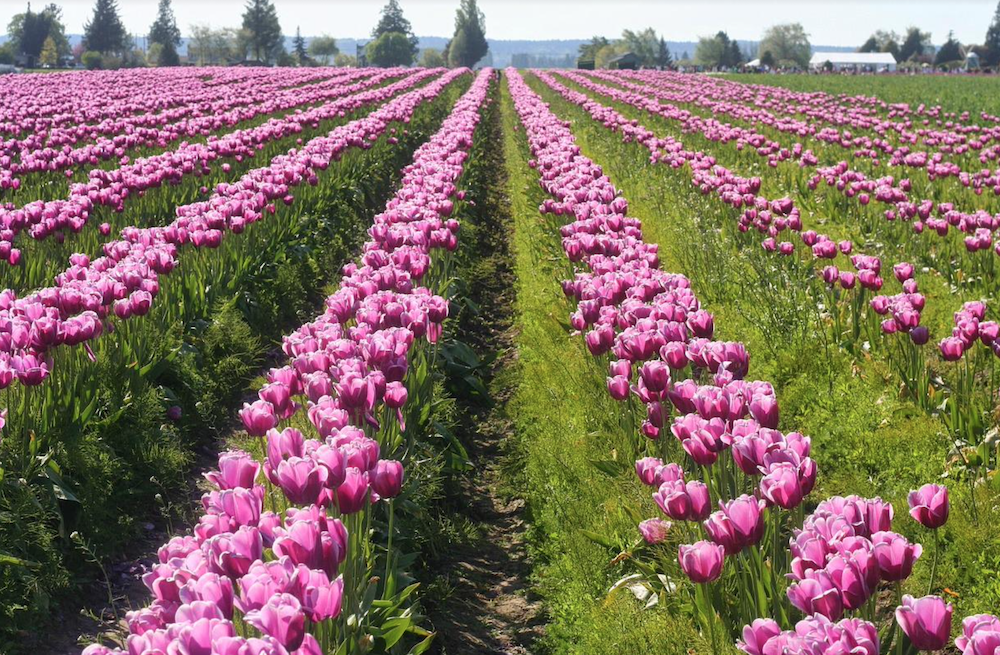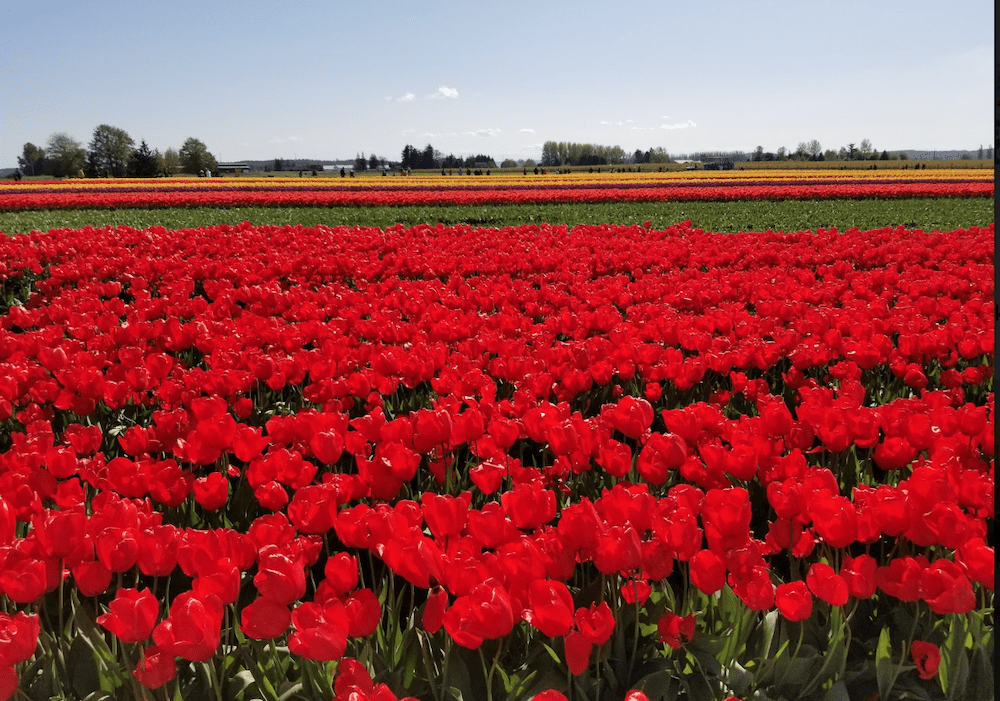Why Washington State is the Tulip Capitol of USA
by Tonneli Grüetter
Along the banks of the Skagit River lies the sleepy farm town of Mount Vernon Washington. It is located in a great fertile valley sandwiched between Vancouver BC to the north, and Seattle to the south, and framed by the unreal natural beauty of both sweeping mountain vistas and pristine ocean views.
It is no wonder this region is world-renowned for its natural beauty. This little town and its surrounding area are home to many of the nation’s foremost growers of specialized crops but none stand out quite so much as the cut flower. In fact, it now has one of the world’s greatest tulip festivals lasting throughout April.

Unbeknownst to many, Washington state is the number one grower of tulips in the USA with this single town accounting for an estimated 75% of total domestic cut tulip production.
According to a 2019 study by Washington State University, about 1,000 acres of tulips and daffodils are grown in Skagit County, sold for both cut flowers and bulbs and shipped throughout the U.S. and Canada. About 20 million bulbs are harvested each summer.
This has created a booming business, however, for the industrious tulip farmer, it does not stop there. Where many farmers saw the familiar stability of export, and long before the phrase “agro-tourism” had been popularized, the pioneering flower farmers of Mount Vernon saw an opportunity for tourism.

Beginning in 1984 as a two-day celebration of the tulip harvest, the Skagit Valley Tulip Festival began. Fast forward nearly four decades and the tradition of viewing the tulips has ballooned to a full-blown spectacle bringing in $65 million in revenue, incorporating multiple farms, and now attracting 400,000 global visitors annually over the course of a month. Today, the sleepy fields of Mount Vernon are a hive of activity swimming with happy families and floral photographers chasing the legendary blaze of color swelling from the tulip fields.
Starstruck by the beauty of the Skagit Valley Tulip Festival, this annual flower pilgrimage has gone on to inspire a whole new generation of flower farmers hoping to chase their dreams in the rich soil.
Counted among these new-school farmers are celebrities Triple Wren Farms and Floret Flower Farm but also countless numbers of small farms who rely on cut flowers to support their families, myself included.

So I speak from a place of personal experience when I say climate change is very real, and it is changing how we farm at an ever-accelerating pace. As a farmer, there are many things I actively do to combat changing growing conditions. Shortly after spring harvest each year it is time to plan and secure orders for the following season’s bulb stock. With thousands of dollars on the line, my family sits down to track the weather patterns, flower yields, and cut-flower sales from the previous year in hope of making the most educated purchase choice possible.
As the years have gone on we have adapted to buying different varieties of tulip to combat the short stems which unseasonably warm weather can cause and expanded to growing more warm climate flowers. We have taken other measures to offset climate change too, such as growing an increasing number of spring bulbs in above-ground raised beds to prevent the rotting which has become increasingly troublesome in the wake of major rainfall events.
While I am inspired by and love to share the small steps we can all adopt as individuals to ensure our flowers will still bloom despite the daily stress of climate change, it is undeniable that protecting agricultural communities will take a larger investment in the future when* disaster strikes. Yes, raising my flowers above ground level and digging trenches to divert water has worked in soggy conditions. However, I have always known it would not be enough to protect my tulips which are planted in the fall prior to the rainy season from being swept away in floodwaters when the next eventual disaster struck.
I, along with many other farmers in Mount Vernon found myself sitting on pins and needles recently as a record-breaking “atmospheric stream” touched down. This historic storm sent a deluge of rain into already swelled river beds, quickly pushing the dike system protecting 75% of our nation’s tulips to its limit.
If I were writing this essay 10 years ago the story would have ended there. Breached dikes and catastrophic flooding would have resulted in no spring tulips. However, that is where the spirit of early adoption touched the Skagit valley again. Just as they had pioneered sharing their love of the bloom through agro-tourism back in the 80’s, the farmers of Mount Vernon Washington took a proactive planning approach to climate change as well.
In 2018 we celebrated the ribbon-cutting ceremony for our shiny new river promenade. Years in the making, this 30 million dollar test project featured public art, welcoming seating areas, and even a new home for the local farmers market all framed by beautiful masonry pillars and brick-lined walls hiding a powerful secret. Inside those walls concealed an emergency flood defense system, untested until 2021.
As the river breached previous flood records this winter, residents lined downtown streets nervously watching the rapidly rising Skagit river from a safe view, behind the fully deployed floodwall. What was built as hopeful defense was tested in a real-world disaster with success. The wall worked taking important pressure off key points in the rural levee system, but unfortunately could not protect the entire region. Important swaths of tulip farms were left unprotected. Fields of tulip bulbs were left saturated by the stagnated flood waters over the especially wet winter season, leading to an estimated loss of 80% of the tulip crop for some key farms.
In a 2021 statement, Washington senator Patty Murray was quoted as saying this about the wall. “This protected the Mount Vernon people, property, businesses, families’ homes,”.Senator Murray said. “Instead of standing here in just a little bit of mud, we would be standing here in devastation if that wall had not been there.”
Caught between the painful choice of saving homes or the fields on which they rely, this farm community had to choose where to prioritize testing their new flood technology. What could have been a human safety disaster was prevented through thoughtful planning and community investment,
Weather events like this are not limited to floods, or unique to the NW region. Across the globe, farmers will tell you, that the earth is changing. This is a call to action to invest in more resilient protective infrastructure. From the perspective of a farmer whose home and livelihood were just saved, I must say how life-saving this type of foresight truly is. Because of this my tulips remain exactly as I planted them, preparing beneath the soil for the big show they will put on in the spring.
Thankfully for the flower pilgrims who have made the journey to see them visually. dazzling tulip fields, the crop losses appear less apparent. Despite the flood damage these farmers understand perseverance and have built up a display sure to wow even the farthest-reaching traveler. It’s also a seed planted for the future so everyone can enjoy their flowers.
For more information on visiting the Skagit Valley Tulip Festival which is in bloom through early May please visit https://tulipfestival.org/ for more information.

Tonnelli runs Salty Acres Farm
